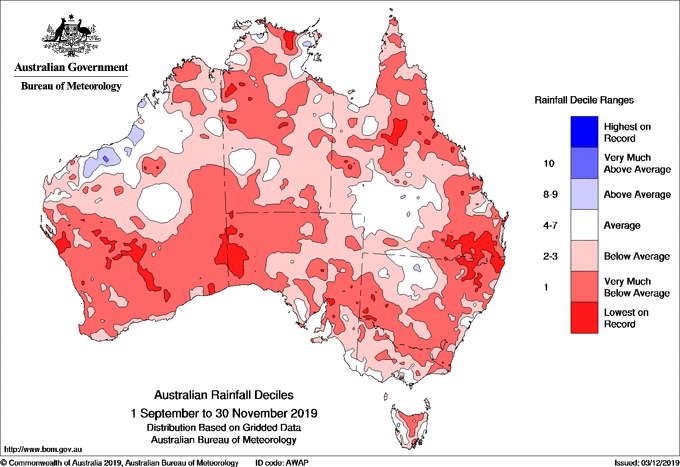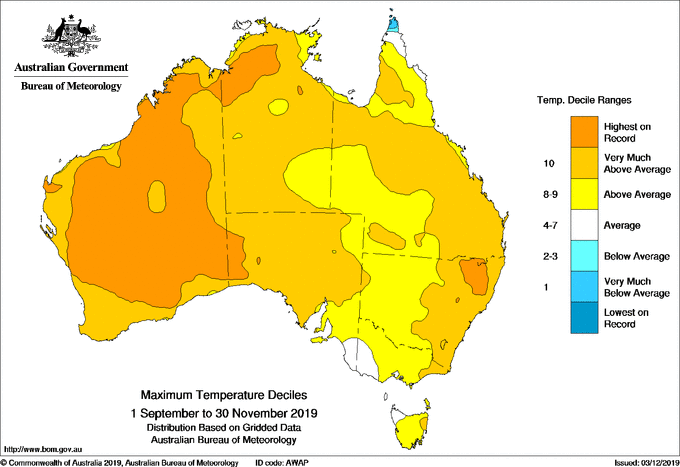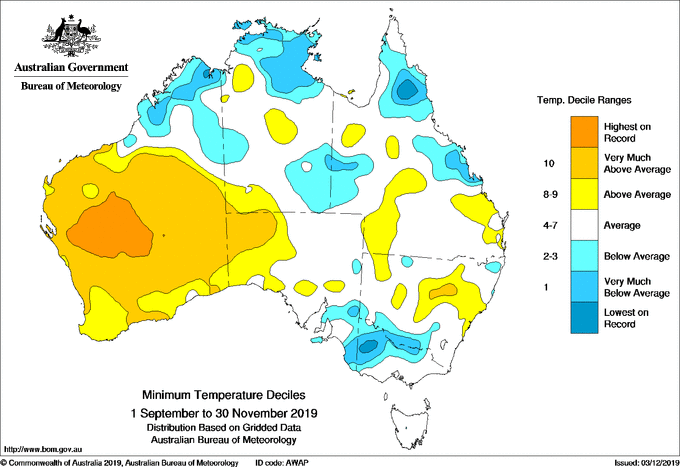Australia's warm, dry spring

Australia just had its driest and second hottest spring on record based on maximum temperatures, exacerbating drought and bushfires across the country.
.jpg)
The last three months were, collectively, exceptionally dry and warm in Australia. The country as a whole registered its lowest spring rainfall on record, with Queensland, NSW, SA, WA and the NT all having one of their top 10 driest springs in 120 years of observations.

Image: Rainfall deciles during spring 2019. Source: Bureau of Meteorology.
Following on from Australia's ninth driest winter on record, this prolonged dry spell has caused drought conditions to worsen across large parts of the country during the last six months. This period of dry weather also aided the development and spread of large bushfires in eastern Australia. According to the NSW Rural Fire Service, two million hectares of land was burnt between July and November.
NSW already has faced its most challenging bush fire season ever. Since July, we have seen lives lost, homes destroyed and communities changed forever. And today is the start of summer.
— NSW RFS (@NSWRFS) November 30, 2019
How fireproof is your plan? #nswrfs #nswfires pic.twitter.com/5dM6yrwU2N
In addition to the lack of rain, Australia also registered its second warmest spring on record based on daytime heat. The national average maximum temperature during spring was a whopping 2.41 degrees above the long term average, beaten only by +2.45 degrees in spring of 2014.

Image: Maximum temperature deciles during spring 2019. Source: Bureau of Meteorology.
But it wasn't hot everywhere and nights were particularly cool in some parts of the country last season.
Some places in Queensland, SA and WA registered their lowest spring temperature on record during the opening 10 days of September. When averaged across the season, parts of northern and southeastern Australia registered notably cool spring nights.

Image: Minimum temperature deciles during spring 2019. Source: Bureau of Meteorology.
Looking more locally, Perth, Hobart and Melbourne all matched or exceeded their highest spring temperature on record during November. According to Monash University, Hobart's peak spring temperature has increased by more than 3.5 degrees during the last five decades. In Melbourne, the highest temperature in November has climbed by more than 4 degrees during over the last 50 years.
In eastern Australia, Sydney registered its hottest November and second hottest spring on record based on maximum temperatures. Rainfall was also below average in Sydney during spring, with the city's water supply dipping below 46 percent of its capacity at the end of November.
Further north, 11 locations in southeast Queensland registered their driest spring in more than a century of records. For Brisbane, last season was the city's driest spring in 51 years.